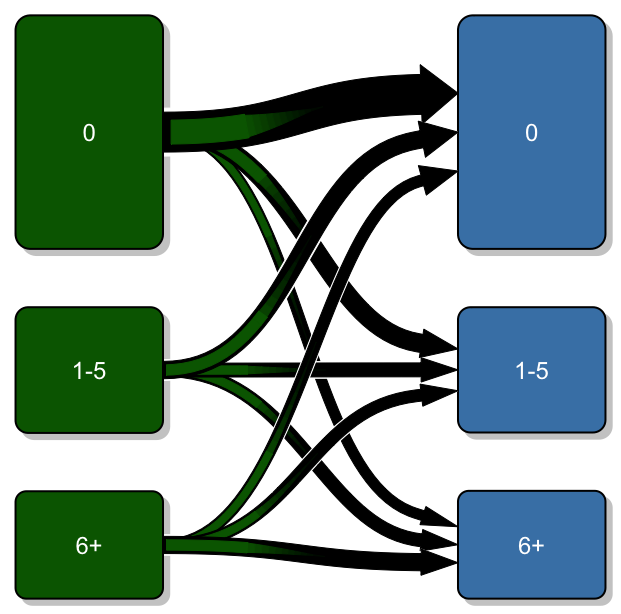markovchain
markovchainパッケージは、離散状態離散時間マルコフ過程(通称は離散マルコフ過程、あるいはマルコフ連鎖)をRで扱うのに便利な機能を提供する。以下の説明は、https://cran.r-project.org/web/packages/markovchain/vignettes/an_introduction_to_markovchain_package.pdfに基づいている。
このパッケージはR 3.5.0以上を必要とする。各自でダウンロードしてインストールする必要があるかもしれない。
マルコフ解析
マルコフ過程に基づいて現象の性質を明らかにしたり、未来の時点のおける状態の確率分布を推定することなどを、マルコフ解析という。
マルコフ解析に必要なもの
マルコフ解析に必要なものは、現在の状態もしくは初期の状態と、対象の状態遷移行列である。
- 状態
- 状態遷移行列
天気の移り変わりを例に説明を進める。
weatherStates <- c("sunny", "cloudy", "rain")
byRow <- TRUE
weatherMatrix <- matrix(data = c(0.70, 0.2, 0.1, 0.3, 0.4, 0.3, 0.2, 0.45, 0.35), byrow = byRow, nrow = 3, dimnames = list(weatherStates, weatherStates))
mcWeather <- new("markovchain", states = weatherStates, byrow = byRow,
transitionMatrix = weatherMatrix, name = "Weather")
markovchainのメソッド
| Method | Purpose |
| * | Direct multiplication for transition matrices. |
| [ | Direct access to the elements of the transition matrix. |
| == | Equality operator between two transition matrices. |
| as | Operator to convert markovchain objects into data.frame and table object. |
| dim | Dimension of the transition matrix. |
| names | Equal to states. |
| names← | Change the states name. |
| name | Get the name of markovchain object. |
| name← | Change the name of markovchain object. |
| plot | plot method for markovchain objects. |
| print method for markovchain objects. | |
| show | show method for markovchain objects. |
| sort | sort method for markovchain objects. |
| states | Name of the transition states. |
| t | Transposition operator (which switches byrow slot value and modifies the transition matrix coherently). |
markovchainの使い方の基本
上で定義したマルコフ連鎖を確認しておく。
weatherStates weatherMatrix mcWeather
さて、初期状態は曇りcloudy。
initialState = c(0, 1, 0)
二日後の天気の確率分布を求めてみる。
after2Days <- initialState * (mcWeather * mcWeather)
求めた確率分布を確認する。
after2Days
7日後の天気の条件付き確率分布を推定する。
after7Days <- initialState * (mcWeather ^ 7)
求めた確率分布を確認する。
after7Days
こんなに長い桁は必要ないので、四捨五入して小数点以下第3位まで表示してみる。
round(after7Days, 3)
状態を列ベクトルで表すなら、すべてを転地すればいい。
initialState <- c(0, 1, 0) after2Days <- (t(mcWeather) * t(mcWeather)) * initialState after7Days <- (t(mcWeather) ^ 7) * initialState after2Days
fvals<-function(mchain,initialstate,n) {
out<-data.frame()
names(initialstate)<-names(mchain)
for (i in 0:n)
{
iteration<-initialstate*mchain^(i)
out<-rbind(out,iteration)
}
out<-cbind(out, i=seq(0,n))
out<-out[,c(4,1:3)]
return(out)
}
fvals(mchain=mcWeather,initialstate=c(90,5,5),n=4)
関数statesはマルコフ連鎖のオブジェクトmcWeatherの中の状態の一覧を表示させる。
states(mcWeather)
関数namesもstatesと同じ動作をする。
names(mcWeather)
関数dimは状態数を返す。
dim(mcWeather)
関数nameはマルコフ連鎖の名前を返す。これはnewで作成するときにつけている。
name(mcWeather)
markovchain:::sort(mcWeather)
transitionProbability(mcWeather, "cloudy", "rain")
mcWeather[2,3]
print(mcWeather)
show(mcWeather)
plot(mcWeather, package="diagram",box.size = 0.04)
mcDf <- as(mcWeather, "data.frame") mcNew <- as(mcDf, "markovchain") mcDf
mcIgraph <- as(mcWeather, "igraph")
require(msm) Q <- rbind ( c(0, 0.25, 0, 0.25), c(0.166, 0, 0.166, 0.166), c(0, 0.25, 0, 0.25), c(0, 0, 0, 0) ) cavmsm <- msm(state ~ years, subject = PTNUM, data = cav, qmatrix = Q, death = 4) msmMc <- as(cavmsm, "markovchain") msmMc
myMatr<-matrix(c(.1,.8,.1,.2,.6,.2,.3,.4,.3), byrow=TRUE, ncol=3) myMc<-as(myMatr, "markovchain") myMc
マルコフ連鎖の確率推論
| Method | Returns |
| absorbingStates | the absorbing states of the transition matrix, if any. |
| steadyStates | the vector(s) of steady state(s) in matrix form. |
| communicatingClasses | list of communicating classes. sj , given actual state si. |
| canonicForm | the transition matrix into canonic form. |
| is.accessible | verification if a state j is reachable from state i. |
| is.irreducible | verification whether a DTMC is irreducible. |
| period | the period of an irreducible DTMC. |
| recurrentClasses | list of recurrent classes. |
| steadyStates | the vector(s) of steady state(s) in matrix form. |
| summary | DTMC summary. |
| transientStates | the transient states of the transition matrix, if any. |
conditionalDistribution(mcWeather, "sunny")
steadyStates(mcWeather)
absorbingStates(mcWeather)
summary(mcWeather)
transientStates(mcWeather)
is.accessible(object = mcWeather, from = "sunny", to = "cloudy")
period(mcWeather)
firstPassage(object = mcWeather, state = "sunny",n = 10)
マルコフ連鎖のための統計的推測
| Function | Purpose |
| markovchainFit | Function to return fitted Markov chain for a given sequence. |
| predict | Method to calculate predictions from markovchain or markovchainList objects. |
| rmarkovchain | Function to sample from markovchain or markovchainList objects. |
状態遷移のデータがあるとする。
Alofi島の1日あたりの降雨のデータがある。
data(rain)
このデータは、2つのフィールドV1とrainを持つ。使うのは rain の方。 一日ごとの推移を集計してみる。
table(data.frame(before=rain$rain[-1], after=rain$rain[-length(rain$rain)]))
出力は次の通り。
after before 0 1-5 6+ 0 362 136 50 1-5 126 90 79 6+ 60 68 124
この推移をグラフに表してみる。Gmiscパッケージの中の関数transitionPlotを使うために、準備をする。
install.packages(c("rms","sandwich","stringr","Hmisc"))
reps = c("http://ftp.sunet.se/pub/lang/CRAN","http://cran.gforge.se")
install.packages("Gmisc", repos=reps, dependencies=TRUE, type="source")
そして、使ってみる。
require(Gmisc) transitionPlot(table(data.frame(r1=rain$rain[-1],r2=rain$rain[-length(rain$rain)])), overlap_add_width=1.2,type_of_arrow="gradient", min_lwd = unit(2, "mm"), max_lwd = unit(15, "mm"),cex=1.5)
library(dplyr) library(stringr) library(DiagrammeR) library(networkD3)
この準備で頑張ると、こんなグラフも描けるらしい。
この推移から、遷移行列を推定する。
markovchainFit(rain$rain, method="mle", byrow=TRUE)
次の推定値などが表示される。
$estimate
0 1-5 6+
0 0.6605839 0.2299270 0.1094891
1-5 0.4625850 0.3061224 0.2312925
6+ 0.1976285 0.3122530 0.4901186
$standardError
0 1-5 6+
0 0.03471952 0.02048353 0.01413498
1-5 0.03966634 0.03226814 0.02804834
6+ 0.02794888 0.03513120 0.04401395
$confidenceLevel
[1] 0.95
$lowerEndpointMatrix
0 1-5 6+
0 0.6034754 0.1962346 0.08623909
1-5 0.3973397 0.2530461 0.18515711
6+ 0.1516566 0.2544673 0.41772208
$upperEndpointMatrix
0 1-5 6+
0 0.7176925 0.2636194 0.1327390
1-5 0.5278304 0.3591988 0.2774279
6+ 0.2436003 0.3700387 0.5625151
$logLikelihood
[1] -1040.419
rain.MCに代入しておく。
rain.mcfit <- markovchainFit(rain$rain, method="mle", byrow=TRUE)
返して貰った内容を見てみる。
str(rain.mcfit)
rain.MCはS3オブジェクトのリストだが、rain.MC estimate@transitionMatrix
</code>
estimate@transitionMatrix
</code>
これによって新たなマルコフ連鎖を定義するには、次のように書く。
mcrain = new("markovchain", states = rain.mcfit$estimate@states,
byrow = TRUE,
transitionMatrix = rain.mcfit$estimate@transitionMatrix, name = "rain")
関数markovchainFitは、markovchainオブジェクトをリストの要素として出力しているので、そちらを使うのも良い。
mcrain = rain.mcfit$estimate
rain.mcfit <- markovchainFit(rain$rain, method="laplace", laplacian=0.5, byrow=TRUE)

